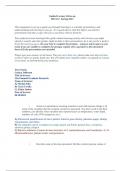Guided Lecture Write-up
BIO 112 Spring 2023
This assignment is set up to guide you through listening to a scientific presentation, and
understanding and learning as you go. It’s a good idea to read this before you attend a
presentation and take a copy with you so you know what to listen for.
Your professors have developed this guide without knowing exactly which lecture you might
attend or exactly what the speaker might include in their presentation. So it may not be a perfect
fit for the event you go to. Do your best to complete the prompts – using as much space as you
need; if you are unable to complete the prompt, explain why a question in this document
doesn’t fit the presentation you attended.
Please type your answers in the boxes. They are set to blue text; please make sure they are blue,
so this is easier to grade, thank you. You will submit your response online, via upload on Canvas
or by email, as determined by your professor.
Your Name:
Ceniya Jefferson
Title of lecture:
23rd Annual Graduate Research
Name of lecturer:
A) Nicolas Klei
B) Chris Favilla
C) Claire Stokes
Date of lecture:
04/18/2024
• Science is quantitative meaning scientists count and measure things. List
some of the variables that the scientist counted or measured. You don’t need to list their
numbers, just identify what variables they reported (such as temperature, water depth,
numbers of cells, DNA sequences, etc.)
A) Fluorescent quantification of micro plastics found in grass shrimp, palomino pugio; shrimp,
concentration, and chiton
B) The allegedly narrow exemption in using Lukumi and Smith; general laws, exceptions,
minority groups, religion
C) Relative stabilities of amino & nitro derivative of 9- methylnthrecene and 9-methylene -9, 10-
dihydroanthracene; plantar isomer, and geometrics
• Describe some of the data presented. Did the scientist present values of
, variables as tables of numbers? Graphs? Diagrams showing a sequence of events?
A) Yes, 368 million tons of total production, 19-31% mortality when exposed to micro plastics,
83% biomass, and changed incubation of 50 C to 48h over vortexing of vial every 12h for 30 sec
each.
B) No
C) Yes. Adding amino group to favor the plantar. The - number was found to save the plantar in
favor. The more gross added, the more -s. The amino group was also showing a non-plantar
group. For both 2-amino deviation and 2 nitro, plantar was more stable then the present systems
relative to the nonpolar.
A hypothesis is a testable statement about the interaction between two variables. Sometimes it is
formed as a question. For example, “The dose of medication affects how rapidly the symptoms
disappear.” or maybe “Does the dose of a drug affect the amount of pain reported by the
patient?” A hypothesis can be tested by performing an experiment, but many hypotheses are
testable by observations only.
(Note that an experiment is when a scientist chooses or manipulates the value of one or more
variables, such as the dose of a drug, the nutrients in a diet, or the density of seeds planted).
• Did the scientist report the results of experimental tests of hypotheses?
A) Yes
B) Yes
C) Yes
• If your answer was YES, what hypothesis did the scientist test?
A) Due to the amount of micro-plastics, will it affect the growth, reproduction and mortality of
grass shrimp
B) The bending of rules for using the lukumi tool as a court case
C) Investigated different derivatives of parent isomers to determine affects with plantar
• What variable did the scientist manipulate? This is called an independent
variable.
A) Protocols, shrimp, and temperature
B) Lukumi, minority groups, and covid responses
C) Amino groups
• What response did the scientist measure, count, or observe? This is called a




